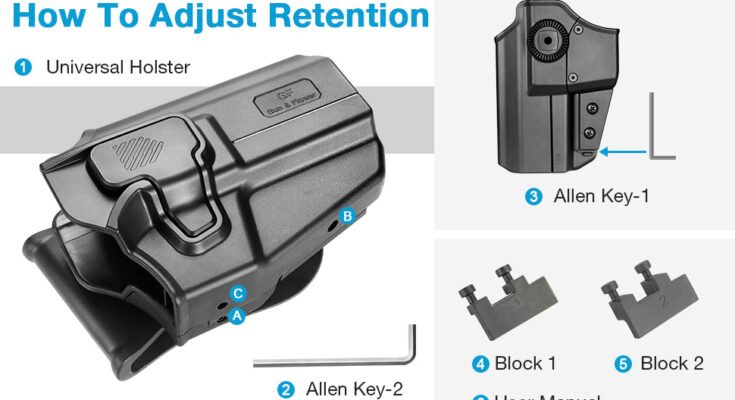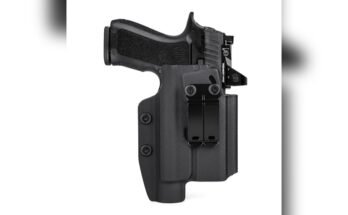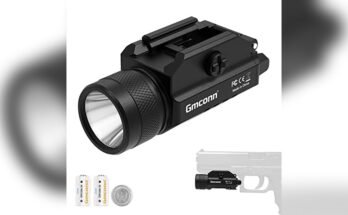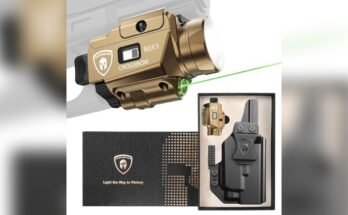If you carry a handgun, you know that a holster is more than a place to stash gear. It is a safety system. I have spent years fitting holsters for students, officers, and concealed carriers. The most common issue I see is poor retention. This guide shows you how to adjust a retention holster the right way. You will learn how to set tension, tune active locks, and test your setup. If you have asked how to adjust a retention holster, you are in the right place.
Before you touch your holster, work safe and simple.
- Unload your firearm and remove all live ammo from the room.
- Verify the chamber is clear by sight and touch.
- Use a blue gun or a barrel block if you have one.
- Work over a clean, stable surface with good light.
A clean start lowers stress and keeps you focused. It also makes each step feel smooth and repeatable.

Know Your Holster Type And Retention Level
Not all retention holsters adjust the same way. Identify what you have.
- Friction or compression retention uses tension screws or molded fit. Common on Kydex and hybrid holsters.
- Level 2 adds one active device. This may be a thumb release or hood.
- Level 3 and up adds a second device. This includes hoods plus levers or rotating guards.
Your holster manual explains the parts. Most makers use tension screws with rubber spacers for fine control. Duty holsters use adjustable hoods or lever timing.

Tools You Will Need
You do not need a bench full of gear. Keep it simple and correct.
- The correct driver for your screws. This is often a Phillips, flathead, or hex key.
- A small bottle of medium thread locker for final set.
- A soft cloth for wiping dust and grit.
- A blue gun or cleared firearm for testing.
Having the right driver avoids stripping heads and cracking the holster body.

How Retention Works: The Quick Science
Great retention balances grip and release. Too tight and you fight the draw. Too loose and the gun can shift or fall.
- Passive retention is friction at contact points. Common at the trigger guard and slide.
- Active retention is a lock you must defeat on purpose. Good for duty and open carry.
- Draw stroke efficiency depends on the first inch of movement. You want a clean break with no stick-slip.
Aim for a “click-in, clean-out” feel. That feel is the gold standard for most Kydex holsters.

Step-By-Step: Adjusting Friction Retention Screws
Most Kydex holsters use one or two tension screws with rubber spacers. Here is the method I teach students.
- Insert the unloaded firearm into the holster until fully seated.
- Turn each tension screw a quarter turn at a time. Tighten in small, even steps.
- Perform a slow draw. Then a fast draw. Listen and feel for the snap at the trigger guard.
- Hold the holster upside down over a couch or mat. Shake gently. The gun should stay put.
- Repeat small adjustments until the gun clicks in and draws clean.
- Add a small dot of medium thread locker to each screw once dialed. Do not soak the rubber.
Tip from the field: Adjust both screws evenly. If you only crank one, the shell can warp and rub the slide.
Tuning Level 2 And Level 3 Devices
Active retention adds a hood, lever, or rotating guard. The right setup makes release automatic as your grip forms.
- Practice the release with an empty holster first. Build the habit with your thumb where it will live on the grip.
- Seat the gun and test the release. If the hood binds, check for debris and proper seating.
- Some hoods have a tension screw or timing set. Adjust a quarter turn at a time.
- Your support hand should not be needed to defeat the device.
- Test from standing, seated, and with a cover garment if you conceal.
Golden rule: The device should open as part of your master grip, not after it.
Ride Height, Cant, And Belt Fit
Retention is not only about screws. Fit and angle change how the holster holds and releases.
- Ride height controls leverage. Lower ride can add stability but slow the grip. Higher ride can speed access but may feel loose.
- Cant changes the draw path. Forward cant can lock the gun into your body and reduce printing.
- Belt width and stiffness matter. Use a belt that matches the holster slots or clips.
Set ride and cant first. Then fine tune the retention screws. This avoids chasing the same problem twice.
Testing Protocol: Make It Real
A good test builds confidence. Run this short checklist after each adjustment.
- Conduct 25 slow draws while watching your grip.
- Conduct 25 fast draws with a clean press out. No ammo in the room.
- Do 10 jump steps, 10 squats, and 10 short sprints in place. The gun must stay seated.
- Sit, stand, drive position, and kneel. Check for comfort and pinch.
- End with eyes closed draws to feel for snag or delay.
Log what you changed and what you felt. Small notes help you repeat success.
Common Mistakes And How To Avoid Them
I have fixed the same errors many times for students. Avoid these to save time.
- Over-tightening screws cracks Kydex and crushes spacers. Use quarter turns.
- Ignoring the belt makes draws inconsistent. Use a rigid, matched belt.
- Forgetting thread locker leads to drift. Lock it in after final tune.
- Skipping function tests. Movement exposes flaws that a static draw will not.
- Setting retention for one cover garment only. Test with your real wardrobe.
Small, patient changes beat big swings every time.
Maintenance: Keep Retention Consistent
Retention drifts when parts wear or collect grit. A fast monthly check helps.
- Remove lint and dust with a soft cloth and a dry brush.
- Inspect screws, spacers, and clips for wear or cracks.
- Check for heat warping if you left the holster in a car.
- Recheck tension after heavy training or weather shifts.
- Replace worn spacers or damaged screws on schedule.
Consistent care keeps the feel you worked to achieve.
Special Notes For Concealed And Duty Carry
Different roles need different retention strategies. Dial the right balance.
- Concealed carry favors smooth, quiet draw and comfort. Aim for strong passive retention and clean garment clear.
- Duty or open carry needs active retention at Level 2 or higher. Train the release until it is subconscious.
- Range use can be looser for speed, but never so loose that movement dislodges the gun.
- Off-body carry requires extra checks. Bags and packs flex and can press on the shell.
Set your standard based on the real risk and your training time.
Personal Lessons From The Field
I once set a student’s holster too tight for a rainy night class. Cold hands plus high tension turned every draw into a fight. We backed off each screw by one quarter turn, added a drop of thread locker, and retested. The click returned, and his time to first shot dropped by half a second without losing security.
Another time, an officer’s Level 2 hood dragged due to dried mud from a drill. A five-minute clean and a tiny timing tweak fixed it. The lesson is simple. Do small changes, test in motion, and keep it clean.
Frequently Asked Questions Of How To Adjust A Retention Holster?
How Tight Should My Retention Be?
Your holster should hold the gun during light shakes and movement, yet allow a smooth, one-handed draw. Aim for a clear click-in and a clean break on the first inch of movement.
Do I Need Thread Locker On Tension Screws?
Yes, a small drop of medium thread locker helps prevent drift. Apply only after you finish adjustments and let it cure per the label.
How Often Should I Recheck Retention?
Check monthly, after any long training day, and after big temperature changes. Also recheck if you change belts, ride height, or cant.
Can I Adjust A Level 2 Holster Without Tools?
Many Level 2 devices rely on built-in levers and hoods. Some have set screws for timing or tension. You may need the proper driver for fine tuning.
Why Does My Holster Feel Different Day To Day?
Belt stiffness, placement, clothing pressure, and heat can change feel. Mark your belt hole, place the holster in the same spot, and keep screws locked.
Will A Thicker Belt Change Retention?
Yes. A stiffer, proper-width belt reduces flex and can make retention feel stronger and more consistent.
Is It Safe To Practice Draws At Home?
Yes, if you unload the firearm, remove ammo from the room, and follow strict dry practice rules. Use a safe backstop whenever possible.
Wrap-Up And Next Steps
A well-tuned retention holster makes carry safer and faster. Start with safety, set ride height and cant, and then dial tension in quarter turns. Test in motion, lock the screws, and build the release into your grip. Small steps and steady checks keep your setup consistent.
Put this guide to work today. Do the five-minute test and log your results. If you found this useful, subscribe for more carry tips, share with a friend, or drop a question in the comments.



